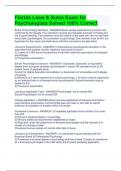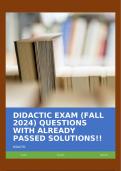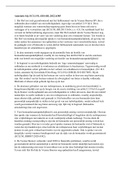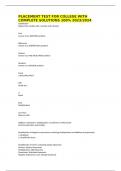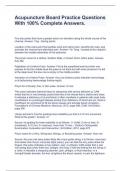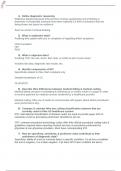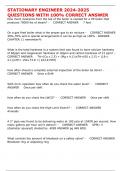LINGUISTICS 3; English Syntax and Syntactic Argumentation
Chapter 1
Universal Grammar
- a theory developed by Noam Chomsky
- which says that Language (with a capital L) is:
- something all humans share
- is innate
- has rules
Principles
Principles: things that (as far as we know) happen in all human languages
- All languages can ...
- Caveat: as far as we know
- Not all human languages have been investigated
- And we don’t know about non-human languages (whale song)
Parameters
How languages differ
Linguistic competence vs. linguistic performance
Linguistic competence is someone’s knowledge of the language, whereas linguistic performance is the
ability of producing the language. Someone’s linguistic competence doesn’t necessarily reflects
someone’s linguistic performance.
Where is language?
In the left hemisphere of the brain. The left hemisphere controls the right-hand side of the body (and
vice versa). Some left-handed people have language on the right-hand side of their brain—but most do
not. The right hemisphere controls music and spatial relations. The left hemisphere controls
mathematics and language
Linguists are divided on the question whether humans have language because they have mathematics or
vice versa (see the works of Steven Pinker if you’re interested). Did Language take a free ride on
mathematics? -> Both are regulated by rules. They have a structure-dependency.
, Chapter 2
Most optimal structural representation
- Hierarchical relations between syntactic items (which parts belong together; constituency)
- What the relation is between the parts (complements; modifiers)
Evidence of levels in the NP
One-replacement: one replaces the intermediate level, N’
I like [NP this [N' blue Dutch tulip]] and you like that one.
I like [NP this blue [N' Dutch tulip]] and you like that red one.
I like [NP this blue Dutch [N' tulip]] and you like that red Turkish one.
Complement and modifier in the NP
- Complement is sister of N
- Modifier is sister of N’
- Same for other lexical phrases (VP, PP, AP)
Evidence of levels in the VP
Do so-replacement: do so replaces the intermediate level, V’
The woman [VP made a cake on Sunday] and the man did so too.
The woman [VP made a cake on Sunday] and the man did so on Monday.
* The woman [VP made a cake on Sunday] and the man did so a quiche on Monday.
Evidence of levels in the PP
Substitution by so
Anna was utterly in love.
Anna was [PP utterly in love ] and Tim was only partly so.
Evidence of levels in the AP
Substitution by so
Anna was very afraid of lions.
Anna was [AP very afraid of lions ], and Tim was less so.
C-command
A node (B) c-commands its sisters (C) and every node that its sisters dominate (D,
E, F, G)
, CHAPTER 3
X-bar theory
All syntactic phases are structured according to the same principles.
- This is called the X-bar theory of phrase structure
- In this representation, X can be any head (N, V, P, A)
- Complement, adjunct and specifier are phrases (YP, ZP, UP)
Ingredients of X-bar theory
- Every syntactic phrase has a head. / Every head projects a phrase
- All levels (X, X', XP) must be projected (no level can be skipped)
- The head X (may) take a complement phrase and they form an intermediate category (X')
- X' can be sister to a phrasal category, the specifier, and they form the phrase (XP)
- An adjuncts is sister to X' and together with that forms another X' level
Positions in a phrase
- Head
- The core of the phrase, which dictates what category it will be
- Complement
- Sister to the head & immediately dominated by X'
- Generally obligatory relative to a head in VPs and PPs (but not in APs/NPs)
- Adjunct
- Sister to an X' and immediately dominated by X'
- Optional (says something 'extra' about the element it modifies)
- Specifier
- Sister to an X' and immediately dominated by XP
- Gives more information about the head - makes it more “specific”
Recursion
Adjunct
These expensive beautiful blue Dutch tulips.
She made a cake on Sunday alone while listening to Ali B.
Complements and adjucts
Complements are adjacent to the head, adjuncts need not be
- a student of physics with long hair
- *a student with long hair of physics
- The dinosaur danced the tango on Saturday after the party.
- The dinosaur danced the tango after the party on Saturday.
- *The dinosaur danced after the party the tango on Saturday.
Complements and adjuncts cannot be coordinated
- *a student of physics and with short arms
Complements can be moved out of the NP, while adjuncts can’t:
- Which branch of physics is Jack a student of?
- *What kind of hair is Jack a student with?
Chapter 1
Universal Grammar
- a theory developed by Noam Chomsky
- which says that Language (with a capital L) is:
- something all humans share
- is innate
- has rules
Principles
Principles: things that (as far as we know) happen in all human languages
- All languages can ...
- Caveat: as far as we know
- Not all human languages have been investigated
- And we don’t know about non-human languages (whale song)
Parameters
How languages differ
Linguistic competence vs. linguistic performance
Linguistic competence is someone’s knowledge of the language, whereas linguistic performance is the
ability of producing the language. Someone’s linguistic competence doesn’t necessarily reflects
someone’s linguistic performance.
Where is language?
In the left hemisphere of the brain. The left hemisphere controls the right-hand side of the body (and
vice versa). Some left-handed people have language on the right-hand side of their brain—but most do
not. The right hemisphere controls music and spatial relations. The left hemisphere controls
mathematics and language
Linguists are divided on the question whether humans have language because they have mathematics or
vice versa (see the works of Steven Pinker if you’re interested). Did Language take a free ride on
mathematics? -> Both are regulated by rules. They have a structure-dependency.
, Chapter 2
Most optimal structural representation
- Hierarchical relations between syntactic items (which parts belong together; constituency)
- What the relation is between the parts (complements; modifiers)
Evidence of levels in the NP
One-replacement: one replaces the intermediate level, N’
I like [NP this [N' blue Dutch tulip]] and you like that one.
I like [NP this blue [N' Dutch tulip]] and you like that red one.
I like [NP this blue Dutch [N' tulip]] and you like that red Turkish one.
Complement and modifier in the NP
- Complement is sister of N
- Modifier is sister of N’
- Same for other lexical phrases (VP, PP, AP)
Evidence of levels in the VP
Do so-replacement: do so replaces the intermediate level, V’
The woman [VP made a cake on Sunday] and the man did so too.
The woman [VP made a cake on Sunday] and the man did so on Monday.
* The woman [VP made a cake on Sunday] and the man did so a quiche on Monday.
Evidence of levels in the PP
Substitution by so
Anna was utterly in love.
Anna was [PP utterly in love ] and Tim was only partly so.
Evidence of levels in the AP
Substitution by so
Anna was very afraid of lions.
Anna was [AP very afraid of lions ], and Tim was less so.
C-command
A node (B) c-commands its sisters (C) and every node that its sisters dominate (D,
E, F, G)
, CHAPTER 3
X-bar theory
All syntactic phases are structured according to the same principles.
- This is called the X-bar theory of phrase structure
- In this representation, X can be any head (N, V, P, A)
- Complement, adjunct and specifier are phrases (YP, ZP, UP)
Ingredients of X-bar theory
- Every syntactic phrase has a head. / Every head projects a phrase
- All levels (X, X', XP) must be projected (no level can be skipped)
- The head X (may) take a complement phrase and they form an intermediate category (X')
- X' can be sister to a phrasal category, the specifier, and they form the phrase (XP)
- An adjuncts is sister to X' and together with that forms another X' level
Positions in a phrase
- Head
- The core of the phrase, which dictates what category it will be
- Complement
- Sister to the head & immediately dominated by X'
- Generally obligatory relative to a head in VPs and PPs (but not in APs/NPs)
- Adjunct
- Sister to an X' and immediately dominated by X'
- Optional (says something 'extra' about the element it modifies)
- Specifier
- Sister to an X' and immediately dominated by XP
- Gives more information about the head - makes it more “specific”
Recursion
Adjunct
These expensive beautiful blue Dutch tulips.
She made a cake on Sunday alone while listening to Ali B.
Complements and adjucts
Complements are adjacent to the head, adjuncts need not be
- a student of physics with long hair
- *a student with long hair of physics
- The dinosaur danced the tango on Saturday after the party.
- The dinosaur danced the tango after the party on Saturday.
- *The dinosaur danced after the party the tango on Saturday.
Complements and adjuncts cannot be coordinated
- *a student of physics and with short arms
Complements can be moved out of the NP, while adjuncts can’t:
- Which branch of physics is Jack a student of?
- *What kind of hair is Jack a student with?


